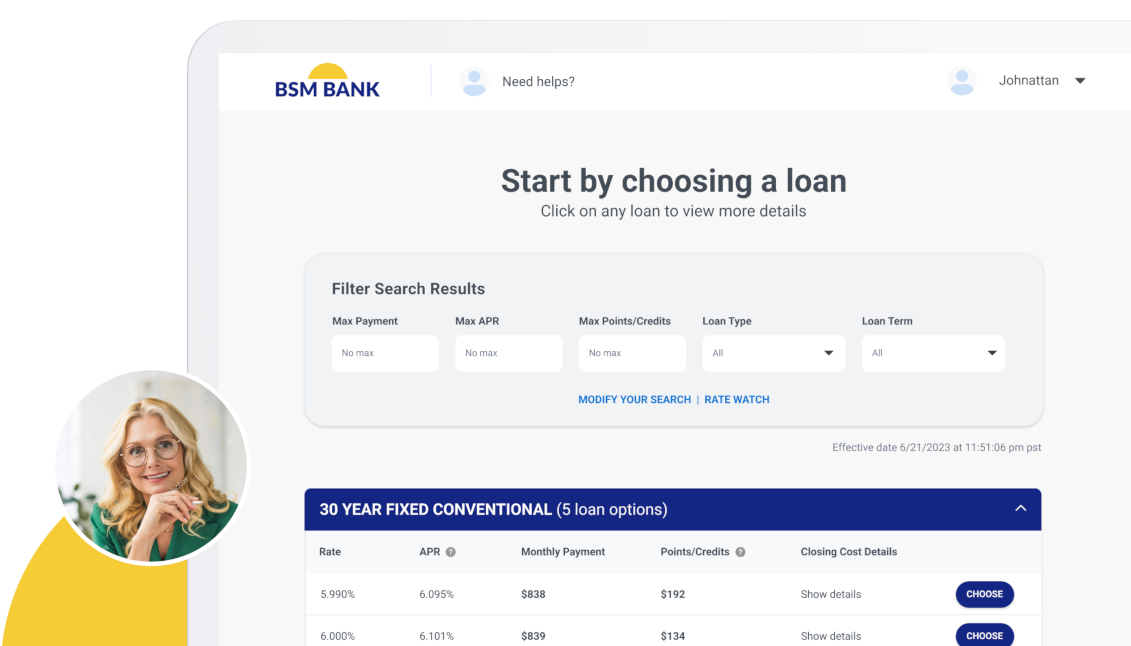In the ever-evolving mortgage lending landscape, staying ahead of the curve is not just an aspiration but a necessity. This is where mortgage technology emerges as a game-changer, allowing lenders to streamline processes, enhance customer experiences and drive operational efficiencies. According to a recent research from Freddie Mac, mortgage companies implementing digital technology can operate at approximately $2,200 less per loan and have production cycles that are 5 days shorter.
However, before diving headfirst into the world of mortgage technology, it’s imperative to understand how to estimate its return on investment (ROI) effectively. In this comprehensive guide, we unravel the intricacies of assessing ROI in mortgage technology implementation, equipping lenders with the knowledge to make informed decisions that will shape the future of their operations.
A loan officer diligently navigates stacks of paperwork, striving to ensure compliance, all while juggling communication with clients. Now, envision the same loan officer seamlessly harnessing the power of automation, effortlessly managing tasks, reducing errors and accelerating loan processing times. This transformation is at the heart of mortgage technology’s potential. Yet, to unlock this transformation, one must venture beyond the surface and dive into ROI estimation.
Mortgage lending is multifaceted, with loan officers shouldering a substantial workload. From meticulous document management to navigating regulatory hurdles, the daily grind often leaves little room for strategic planning. This is where mortgage technology promises relief, but understanding its tangible impact necessitates delving into the numbers.
Calculating ROI in Mortgage Technology
Estimating the return on investment (ROI) in mortgage technology involves a structured approach that considers both the financial gains and strategic benefits that technology implementation can bring. The ability to quantify the impact of mortgage technology is crucial for making informed decisions and demonstrating the value of these investments to stakeholders.
1. Define Key Metrics
The first step in calculating ROI is to identify the key metrics that will be used to measure the impact of mortgage technology. These metrics can include:
Processing Time Reduction: Measure the time saved in loan origination, underwriting and approval processes.
Cost Reduction: Evaluate the decrease in operational costs associated with reduced manual labor, paper usage and error correction.
Increased Loan Approvals: Calculate the percentage increase in approved loans due to more efficient processes.
Customer Satisfaction: Quantify improvements in customer experience, such as faster response times and smoother interactions.

2. Quantify Costs
Next, determine the costs associated with implementing mortgage technology. These costs may include:
Software and Licensing Fees: Calculate the initial and ongoing expenses for adopting and maintaining the technology.
Training and Implementation: Factor in the costs of training employees and integrating the technology into existing workflows.
Change Management: Consider expenses for transitioning to new processes and addressing resistance.
3. Calculate Financial Gains
To calculate the financial gains, subtract the total costs from the comprehensive benefits. For instance:
ROI = (Total Benefits – Total Costs) / Total Costs * 100
4. Include Intangible Benefits
In addition to financial gains, consider intangible benefits that contribute to ROI. These can include:
Enhanced Reputation: Quantify how improved efficiency and customer satisfaction lead to positive word-of-mouth and repeat business.
Risk Mitigation: Estimate the value of reduced errors and improved compliance in preventing costly mistakes.
Competitive Advantage: Assess the impact of being an industry leader in technology adoption and customer-centric operations.
5. Periodic Assessment
ROI estimation is not a one-time endeavor. Continuously monitor and assess the technology’s performance over time. Regularly update the ROI calculation based on evolving data, market conditions and technological advancements.
6. ROI as a Decision-Making Tool
The calculated ROI serves as a powerful tool for decision-making. A positive ROI indicates that the benefits of mortgage technology outweigh the costs, making a solid case for its implementation.
Subscribe to BeSmartee 's Digital Mortgage Blog to receive:
- Mortgage Industry Insights
- Security & Compliance Updates
- Q&A's Featuring Mortgage & Technology Experts
Conversely, suppose the ROI is lower than expected. In that case, it prompts a reevaluation of strategies, potential process improvements, or alternative technology options.
The Benefits of Calculating ROI in Mortgage Technology
Calculating return on investment (ROI) in mortgage technology goes beyond mere number-crunching; it is critical to unlocking many strategic advantages that can propel lenders toward unprecedented success.
Delving into the benefits of ROI calculation quantifies the financial gains, guides decision-making, fosters accountability and paves the way for innovation in the mortgage industry.
1. Informed Decision-Making
decision-making tool. ROI provides a clear, data-driven perspective on technology adoption’s potential benefits and costs.
This empowers lenders to make well-informed choices about implementing technology solutions, ensuring that investments align with the organization’s goals and yield optimal returns.
2. Demonstrating Value to Stakeholders
The ROI calculation is a powerful tool for demonstrating the value of mortgage technology to stakeholders, including executives, shareholders and board members. Tangible figures that showcase cost savings, efficiency improvements and enhanced customer experiences lend credibility to technology initiatives and solidify support for their implementation.
3. Strategic Resource Allocation
By quantifying the financial impact of mortgage technology, lenders can strategically allocate resources. Funds, time and efforts can be directed toward initiatives that promise the highest ROI, ensuring that investments are optimized and aligned with the organization’s growth trajectory.

4. Accountability and Performance Measurement
ROI calculation holds teams accountable for the success of technology implementations. When measurable outcomes are linked to specific initiatives, it becomes easier to track progress, identify areas for improvement and drive continuous optimization.
5. Catalyst for Innovation
Estimating ROI encourages lenders to think critically and strategically about how mortgage technology can drive innovation within their operations. Pursuing a positive ROI often leads to creative problem-solving, process streamlining and adopting new technologies that can further enhance operational efficiency.
6. Risk Management and Mitigation
ROI calculation also aids in risk management and mitigation which can help lenders identify potential pitfalls and address potential benefits. This leads to a more thorough evaluation of risks associated with technology adoption and fosters preparedness in handling challenges that may arise.
7. Data-Driven Continuous Improvement
Calculating ROI is not a one-time event; it’s a continuous process that encourages ongoing analysis and improvement. As technology implementations evolve and market conditions change, lenders can revisit and refine their ROI calculations, ensuring their strategies remain adaptable and aligned with evolving industry trends.
The Future of Calculating ROI in Mortgage Technology
As the mortgage industry continues its journey toward digital transformation, the calculation of return on investment (ROI) in mortgage technology is poised to play an even more pivotal role in shaping the future landscape. Anticipating emerging trends and envisioning the evolution of ROI assessment offers a glimpse into the transformative potential that lies ahead.
1. Data-Driven Precision
The future of ROI calculation in mortgage technology is marked by data-driven precision. Advanced analytics, machine learning and artificial intelligence will enable lenders to gather, analyze and interpret vast amounts of data. This will result in more accurate and granular ROI projections, allowing lenders to make informed decisions with higher confidence levels.
2. Real-Time Decision Support
Integrating real-time data feeds and predictive analytics will empower lenders with on-the-fly ROI estimations. This dynamic approach to ROI assessment will provide instant insights into the potential impact of technology investments, enabling lenders to pivot strategies rapidly and capitalize on emerging opportunities.
3. Holistic Value Measurement
Beyond traditional cost-benefit analysis, the future of ROI calculation will encompass a more holistic value measurement. Intangible benefits, such as improved employee morale, enhanced brand reputation and a strengthened competitive edge, will be quantified to provide a comprehensive view of the overall impact of mortgage technology on an organization’s success.

4. Enhanced Visualization Tools
Visualization tools and interactive dashboards will take center stage in the future of ROI assessment. Lenders can explore various scenarios, adjust variables and simulate outcomes, fostering a deeper understanding of how different technology implementations can influence ROI trajectories.
5. Integration with Ecosystems
In the future, ROI calculations will be seamlessly integrated into larger technology ecosystems. This integration will facilitate the automatic capture of relevant data points and streamline the ROI estimation process, reducing manual effort and enhancing accuracy.
6. Predictive ROI Modeling
Leveraging historical data and market trends, predictive ROI modeling will allow lenders to forecast the long-term impact of mortgage technology investments. This foresight will enable lenders to make strategic decisions that extend beyond immediate gains, contributing to sustained growth and future-proofed operations.
Pioneering Mortgage Lending through ROI Estimation
As the mortgage lending landscape continues to evolve, the role of mortgage technology becomes increasingly pivotal. Lenders can unlock a spectrum of benefits that transcend operational efficiency by effectively estimating ROI. This guide has illuminated the path, offering a comprehensive roadmap for assessing ROI in mortgage technology implementation.
As you navigate this transformative journey, remember that the accurate measure of success lies in cost savings and in creating a seamless and customer-centric mortgage lending experience.
What innovative ways will you integrate mortgage technology to elevate your lending practices? Ready to embark on your ROI journey with mortgage technology? Contact us to gain access to our ROI Calculator and empower your lending strategy today!




